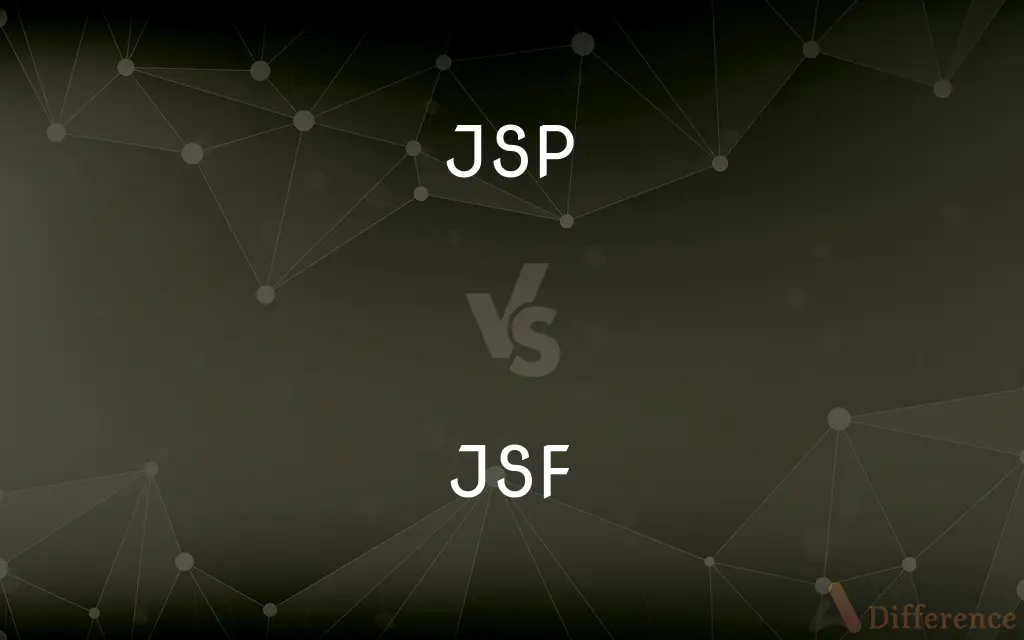JSP vs. JSF — What's the Difference?
By Tayyaba Rehman — Published on January 3, 2024
JSP (JavaServer Pages) is a technology for creating dynamic web pages using Java. JSF (JavaServer Faces) is a Java framework for building user interfaces for web applications.

Difference Between JSP and JSF
Table of Contents
ADVERTISEMENT
Key Differences
JSP is primarily used for creating and displaying dynamic, server-side content on web pages. It allows embedding Java code in HTML pages. JSF, on the other hand, is a Java framework that simplifies the development of user interfaces for Java EE applications. It uses a component-based approach to building web UIs.
In JSP, developers can write Java code directly within the HTML using special JSP tags. This makes it easy to develop and maintain for those familiar with Java and HTML. JSF provides a higher level of abstraction, offering a rich set of UI components and an event-driven programming model, separating the business logic from the presentation layer.
JSP is often used in combination with servlets, where the servlet handles the business logic, and the JSP displays the results. JSF, as a more comprehensive framework, manages the entire MVC (Model-View-Controller) cycle, including navigation, event handling, and rendering processes.
One of the key features of JSP is its simplicity and ease of use for developers familiar with HTML and Java. JSF, with its component-based UI approach, is more suited for complex applications requiring a rich interface and a clean separation of concerns.
JSP is suitable for applications where the emphasis is on the presentation of server-side data. JSF excels in scenarios requiring robust user interface components, such as forms and data validation, and is more scalable for larger applications.
ADVERTISEMENT
Comparison Chart
Primary Use
Creating dynamic web pages with embedded Java code.
Building user interfaces for web applications in Java EE.
Programming Approach
Embedding Java code in HTML.
Component-based UI development.
Integration
Often used with servlets for handling business logic.
Manages the entire MVC cycle, including UI components.
Complexity
Simpler, direct approach suitable for smaller projects.
More complex, suitable for scalable, robust applications.
Key Features
Ease of use for Java/HTML, direct coding style.
Rich set of UI components, event-driven model, abstraction.
Compare with Definitions
JSP
A technology for embedding Java code in web pages.
Created a dynamic webpage using JSP to display user data.
JSF
Suitable for large-scale applications with complex UI requirements.
Optimized the enterprise web application's frontend using JSF.
JSP
Allows building dynamic, server-side content on web pages.
Used JSP tags to fetch and display database records on the website.
JSF
Focuses on building rich and scalable user interfaces.
Created a responsive and data-driven UI with JSF components.
JSP
Often used for simpler web applications requiring Java integration.
Built a small web application with JSP for dynamic content generation.
JSF
Manages UI components in Java EE web applications.
Used JSF to create and manage interactive forms on the website.
JSP
Facilitates the creation of web content with server-side Java.
Developed a user login page using JSP and servlets.
JSF
Provides a higher abstraction level for web interface development.
Implemented an MVC architecture in the web app using JSF.
JSP
Combines Java programming with HTML for web development.
Implemented form handling and data processing using JSP.
JSF
A Java framework for building component-based web interfaces.
Developed a complex web UI using JSF's component library.
Common Curiosities
What makes JSF suitable for enterprise applications?
Its scalability, rich UI component library, and MVC framework.
Can JSP and JSF be used together?
Yes, they can be integrated in the same application for different purposes.
What is JSP used for in web development?
For creating dynamic web pages by embedding Java code in HTML.
Does JSP support a component-based architecture like JSF?
JSP is more about embedding Java code in HTML, not component-based like JSF.
Is JSF a good choice for beginners in Java web development?
It may be complex for beginners due to its component-based approach.
Is JSP easy to learn for Java developers?
Yes, especially for those familiar with Java and HTML.
How does JSP handle user interface components?
JSP can create UI components, but with less abstraction and flexibility compared to JSF.
What is the main purpose of JSF?
To build user interfaces for web applications using a component-based approach.
Can JSF be used for small projects effectively?
While possible, it's generally more suited for larger, more complex applications.
What are the drawbacks of using JSP?
It can become cumbersome for managing complex UIs and doesn't inherently support MVC.
What are the advantages of JSP over JSF?
Simplicity and direct control over the HTML output.
Can JSF handle back-end logic as well as UI?
JSF primarily manages UI, but it can be part of a larger MVC architecture handling back-end logic.
Does JSF provide more features for user interaction than JSP?
Yes, JSF offers a richer set of interactive components.
Is JSP still relevant with the emergence of JSF?
Yes, for certain applications where its simplicity and direct approach are beneficial.
Why might a developer choose JSF over JSP?
For its robust UI components, MVC support, and suitability for complex, scalable web applications.
Share Your Discovery

Previous Comparison
Monarch Butterfly vs. Viceroy Butterfly
Next Comparison
Symmetric Multiprocessing vs. Asymmetric MultiprocessingAuthor Spotlight
Written by
Tayyaba RehmanTayyaba Rehman is a distinguished writer, currently serving as a primary contributor to askdifference.com. As a researcher in semantics and etymology, Tayyaba's passion for the complexity of languages and their distinctions has found a perfect home on the platform. Tayyaba delves into the intricacies of language, distinguishing between commonly confused words and phrases, thereby providing clarity for readers worldwide.
















































